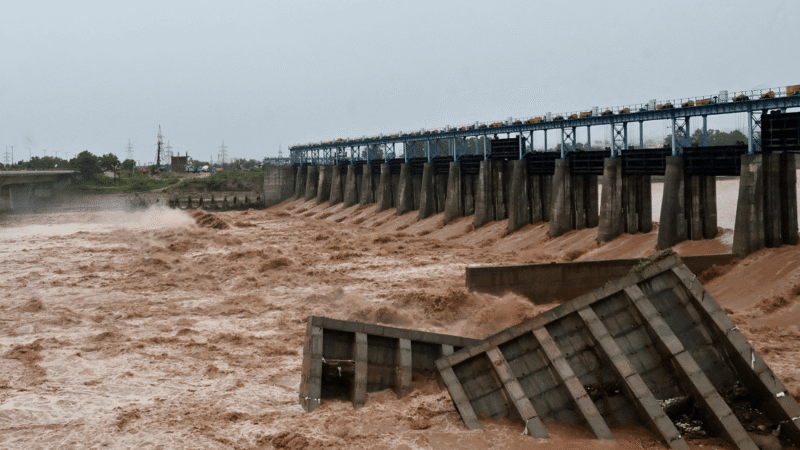 When heavy rains lash Himachal Pradesh, Jammu, and Kashmir, Punjab braces for a deluge. This year, all of Punjab’s rivers are in flood—the Ravi leading the fury, followed by the Beas, and then the Sutlej.Jammu recorded an astonishing 380 mm of rain in just 24 hours—a century-high. That water surged into the Ujh, feeding the already swollen Ravi. At Madhopur headworks, floodgates were mangled, and restraint collapsed. The flood barreled downstream, hitting Pathankot, Gurdaspur, and Ajnala. Across the border in Pakistan, Kartarpur Sahib too staggered under the same surge—because water knows no borders. In 2022 floods in Pakistan the UN calls Pakistan floods ‘monsoon on steroids’, one-third of country under water.
When heavy rains lash Himachal Pradesh, Jammu, and Kashmir, Punjab braces for a deluge. This year, all of Punjab’s rivers are in flood—the Ravi leading the fury, followed by the Beas, and then the Sutlej.Jammu recorded an astonishing 380 mm of rain in just 24 hours—a century-high. That water surged into the Ujh, feeding the already swollen Ravi. At Madhopur headworks, floodgates were mangled, and restraint collapsed. The flood barreled downstream, hitting Pathankot, Gurdaspur, and Ajnala. Across the border in Pakistan, Kartarpur Sahib too staggered under the same surge—because water knows no borders. In 2022 floods in Pakistan the UN calls Pakistan floods ‘monsoon on steroids’, one-third of country under water.
Madhopur Barage damaged
In parallel, the Jhelum crossed danger mark in Kashmir, Ranjit Sagar Dam breached its limit, Pong rose 5 ft in 24 hours, and Bhakra is just 9 ft short of its maximum capacity. The plains are saturated; every extra drop now becomes destructive runoff.
Flying Over the 1988 Flood: A Personal Memory
This crisis dredged up memories of September 1988. I was a student at Guru Nanak Engineering College, Ludhiana, and spent weekends flying from Sahnewal airstrip as a hobby flyer. During those floods, Army choppers buzzed overhead on rescue missions. I took a flight in a bright yellow Pushpak plane and saw from above how Punjab’s fields had turned into vast, muddy lakes, dotted with treetops. The sight seared itself into my memory.
At that time, Haryana’s CM Bhajan Lal controversially called the floods a “boon” that recharged groundwater—a statement that drew widespread outrage. How could flooding—destroying lives and homes—ever be a boon?
Memories of 1988 and 1993

Is former Member of Punjab Public Service Commission
A farmer and keen observer of current affairs
Punjab has seen this before. In September 1988, relentless rains caused by dam releases led to flooding of 9,000 villages, displacing over 3.4 million people—the worst flood in Punjab’s history as all rivers overflowed
Then in July 1993, another devastating flood swept through Punjab. It claimed 350 lives in the state, inundated 1.2 million acres of crops, and disrupted life across northern India. Studies later showed that similar failures—poor drainage, embankment neglect, and stalled preparedness—caused both the 1988 and 1993 floods
In 2023, large areas of Kandi were flooded due to lack of cleaning of the rivulets and choking of the siphon systems over the Bist Doab canal
When Floods Unite, Not Divide
Punjab’s floods don’t stay confined by national boundaries. The torrents that submerge fields in Hoshiarpur or Gurdaspur go on to flood Narowal or Lahore. This year, India has officially informed Pakistan multiple times of the floodwaters heading their way—a small act of bonhomie in a fraught context after the bitterness of Pahalgam attack and the operation Sindhoor
Today’s Crisis: Disturbingly Familiar
The Vaishno Devi landslide which killed 35 pilgrims is stark proof of the Himalayan belt’s fragility. With Ranjit Sagar, Pong, and Bhakra Dams nearing capacity, controlled releases now push floods deeper into Punjab. And with continued rain expected into September, the worst may not yet be over.
From the Pushpak flight of 1988 to today’s inundations, one lesson emerges again and again: we have not learned. We failed to maintain embankments, let sand mining weaken riverbeds, and encroach upon floodplains. This is not just a failure of infrastructure—it is a failure of governance. It will take lot of time to get back to normal.
In both India’s Punjab and Pakistan’s Punjab, floods are a shared inheritance—not of culture or borders, but of waters uniting us in fury. Because water doesn’t see the Radcliffe Line; it follows gravity, and in its path, both Punjabs merge in grief and loss.